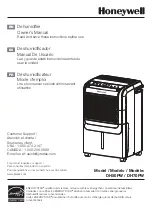
3
www.thermastor.com • [email protected]
Toll-Free 1-800-533-7533
• The air inlet on top & the side outlet must be at least
foot from walls and other obstructions to air flow.
• If the humid area is very large, dehumidification can
be improved by adding an outlet duct to circulate air to
stagnant areas (see Sec. 2.5).
2.3 Electrical Requirements
The Phoenix 200 MAX plugs into a common grounded
outlet on a 5 Amp circuit. It draws 7.4 Amps at 80°F,
60% RH. Amp draw increases with increasing temperature
and\or humidity; e.g. 0.2 amps at 90°F, 85% RH. If used
in a wet area, a ground fault interrupter (GFI) is required.
If an extension cord is required, it must have a minimum of
4 gauge conductors if 25 feet long or less and 2 gauge
conductors if greater than 25 feet long.
2.4 Condensate Removal
The Phoenix 200 MAX is equipped with an internal
condensate pump to remove the water that is condensed
during dehumidification. This allows the condensate to be
pumped 30’ with the attached hose. If the condensate
must be pumped more than 20 feet above the unit, a
second pump must be added to relay the condensate. If
the pump fails and the unit must be used before it can be
replaced, the condensate can be drained by gravity (see
Sec. 4.9).
2.5 Ducting
A detachable rectangular exhaust collar is supplied
that will allow 0” round lay-flat duct to be attached to
the Phoenix 200 MAX outlet. Lay-flat plastic ducting is
available from Therma-Stor.
To attach ducting to a collar, put the plastic duct end
through the collar center and roll the duct end outward
so that it overlaps the outside of the collar. The duct and
collar may then be quickly attached to the Phoenix 200
MAX by snapping the collar over the four screws at the
blower outlet.
2.6 Power Switch
The power switch (right of hour meter) lights up when
the unit is turned on. The unit will continue to run in
all conditions until the switch is turned off; there is no
dehumidistat. If the unit is going to run for more than 2
hours in an area below 50°F, the defrost timer should be
adjusted to improve performance (see Sec. 2.9).
2.7 Pump Purge Switch
This switch (left of hour meter) minimizes the water left
in the condensate pump reservoir for moving or storage.
Pressing and holding the pump purge switch will cause the
condensate pump to run. Hold the switch in until the flow
from the condensate hose stops.
2.8 Hour Meter
The digital hour meter measures the cumulative time that
the unit is turned on to tenths of an hour. It stores its
total when the unit is unplugged; the previous total will be
displayed when the unit is next turned on. It resets to zero
after 99,999.9 hours of operation.
2.9 Defrost Control Adjustment
When the Phoenix 200 MAX is used in a cool area, or the
dewpoint is below 50°, frost will form on the cooling coil
as it dehumidifies. When enough frost forms, the defrost
thermostat will initiate the timed defrost cycle. The cycle
periodically turns off the compressor while allowing the
blower to run. The frost is melted by the air that the blower
draws through the cooling coil.
DRYING TIP: Air’s ability to absorb moisture from wet
surroundings and the Phoenix 200 MAX’s ability to remove
moisture from that air is greatly improved at higher
temperatures. We recommend that the area to be dried be
heated to over 70°F if possible. Less drying time will be
required and efficiency will improve.
The defrost cycle is automatic and designed for optimum
performance above 50°F. If the unit is used in an area that
is below 50°F for more than 2 hours, adjustment of the
defrost timer is recommended. To adjust the defrost timer:
. Unplug the unit.
2. Remove the top panel and the front cover (6 screws).
3. The timer is fastened to the base at the front of the
unit. Every fourth peg around the dial is pushed out
from the dial center except one section with 5 pegs
out in a row. See figure . Each fourth “out” peg
represents 5 minutes of compressor “off” time
during every hour that the unit is in the defrost cycle.
4. To improve performance below 50°F, the compressor
“off” time must be increased to 30 minutes per hour
to allow the frost to completely melt. To do this, push
the pegs out from the dial center so that the pegs
alternate with 2 toward the center, then 2 out from
the center, all the way around the dial except for the
section now with 6 pegs out in a row (see Fig. ).
5. Replace the cover and top panel.
Change the timer pegs back to the original pattern for use
above 50°F.
Above 50° F
Below 50° F
Figure 1: Defrost
timer adjustment





























